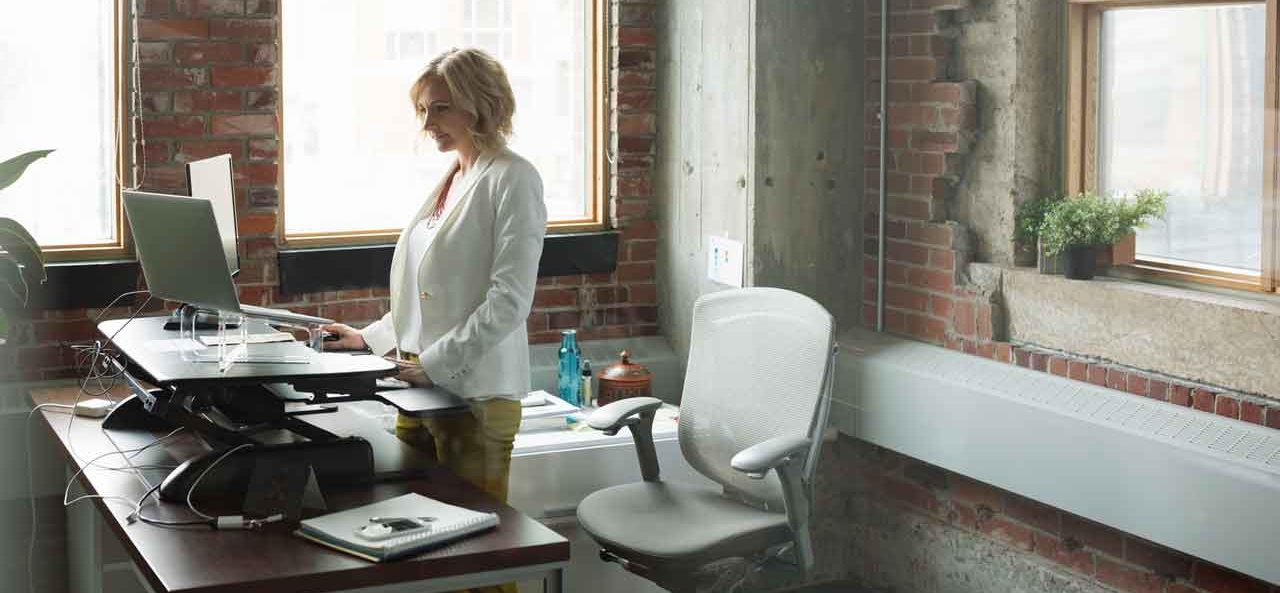Ergonomics in the Workplace

Do you need a standup computer desk? A wrist rest? Ergonomics in the workplace is full of details. But getting things lined up to suit your body could make a big difference.
Ergonomics in the workplace can seem daunting. On most of the controversial questions, says New York City physical therapist Ryan Johnson, the answer is “It depends on your symptoms.” So do what is right for you — but pay attention.
The basics of ergonomics in the workplace
Be sure that the placement of your keyboard, monitor, mouse, and lighting lets you work without straining your eyes or muscles.
Desk chairs should have a reclining back rest, height-adjustable arm rests, a swivel in the base, and a height-adjustable seat. Ideally, your chair will have a yielding mesh back that helps your skin breathe.
YOU MIGHT ALSO LIKE: How to Stay Healthy at Work
Wrist rest
Your goal is to keep your wrists flat, not bent up or down. The pad of a wrist rest should contact the heel or palm of your hand — not your wrist. (An accurate name would be a “hand rest.”) Consider a wrist rest if you have a stiff neck or aching shoulders; resting your palms will help so you’re not holding your hands up all day long.
Adjust your chair, desk, and keyboard so your wrist can stay flat. Line up your palm support to the width, height, and slope of the front edge of the keyboard. It should be soft and rounded, and at least 1.5 inches deep. A folded towel could do the trick.
The downside: putting too much pressure on your wrists. If your wrists hurt or you develop tingling, numbness, or pain in your fingers, reevaluate. Your rest may not be positioned correctly.
The same considerations apply to mouse rests. Make sure you’re not putting more pressure on your wrist.
Mouse platform
Many people reach too far to grab a mouse. One answer is to put a platform over the number section of the keyboard, which you may use rarely. The problem: The platform is raised, and you may need a support for your forearm.
A better alternative for many people is to place a mouse alongside a keyboard that is 14 inches long rather than the standard 18 inches. See these examples of good set-ups from the Canadian Centre for Occupational Health and Safety.
Stand up computer desk
Have you heard that “sitting is the new smoking”? Research suggests that sitting for stretches longer than a half hour actually shortens your life by slowing your metabolism and promoting heart disease, diabetes, and obesity. Sitting is bad for you even if you exercise and aren’t overweight. So stand up or “sit/stand” computer desks came into fashion.
The trouble is that standing all day is also bad for you, straining your legs, knees, and lower back.
An adjustable height computer desk that pops up and down with a hand crank or electric mechanism is a good idea — assuming you’ll actually use the adjustable features. There are also products that you place on top of an ordinary desk. You’ll need to make sure your desk area isn’t loaded up with stuff that makes adjusting the height too cumbersome.
Be realistic: How motivated are you? Field studies led by Cornell ergonomics specialist Alan Hedge found that most people stop using the stand up position after a month.
If you have a stand up or adjustable height computer desk, you might consider also getting a high chair that allows you to sit when you choose to without fussing with your desk height. Be sure there’s a place to prop your feet and that you can keep your neck and arms in a neutral position while looking at the screen and using the keyboard.
What about a treadmill, bicycle, or elliptical contraption under your desk? It turns out that you can use these for reading, but it is very hard to use them while you are using a keyboard or mouse.
The usual advice seems simpler: sit to work, and get up and move for five minutes every half hour. You don’t need to do jumping jacks, Hedge says. But simply standing isn’t enough.
The solution for you may be to keep something you use — your phone, your printer, water — just far enough away that you have to get up and walk to it. If you have to go to the bathroom frequently, consider those many little walks a plus!
YOU MIGHT ALSO LIKE: Break up Hours of Sitting to Protect Your Health
Updated:
April 06, 2020
Reviewed By:
Janet O’Dell, RN